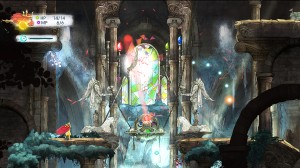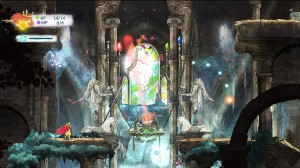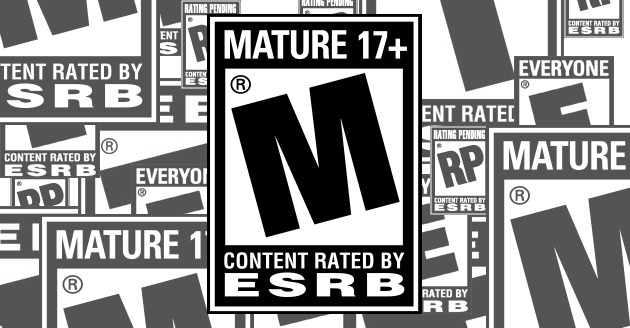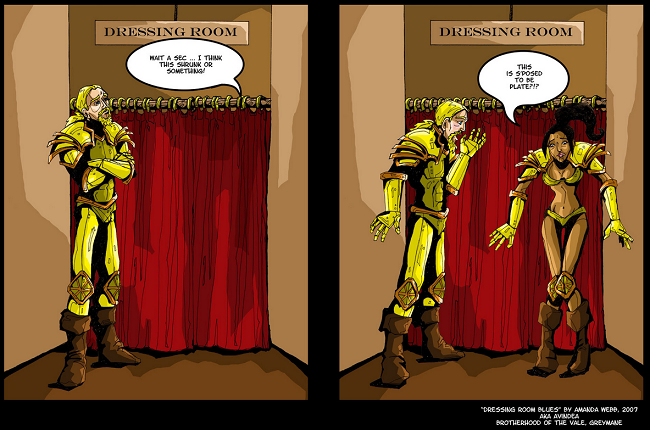“Come, tuck yourself into bed / Let me tell a story / Of Lemuria, a kingdom past /And a girl born for glory,” a woman lyrically instructs as the stylized game begins. Much as it’s opening lines suggest, Ubisoft’s new cross-platform RPG Child of Light in many ways resembles a fairytale. It’s gorgeous setting, poetic dialogue, barefoot young protagonist, mystical call to action, and even the melodic voice of the narrator all resemble something that would be right in place in any classic fairytale. Harnessing the magic of the storybook medium while making use of all the resources a large company like Ubisoft has to offer, Child of Light has left me thoroughly enchanted thus far.
In Child of Light you play as Aurora, the daughter of the Duke of Carniola. One night as she sleeps the fire in her hearth goes out. The cold seeps into her little body and the next morning her father awakes to find her already deceased. But while her body is presumably caught in perpetual slumber, Aurora awakes in the magical land of Lemuria, a kingdom that has been overtaken by the evil Dark Queen. In an effort to return home to her father, Aurora takes up the quest to save this strange but beautiful new land by venturing out to free the moon, the sun, and the stars. With the hidden power of light within her, Aurora is left to wonder if this is all just a dream or if her quest has real repercussions on Lemuria.
The first thing that one notices about Child of Light is undoubtedly its striking design and art style. Everything has been stylized to look like beautiful illustrations. Every environment is crafted with fine detail that not only makes the storybook theme more vivid and palpable but adds a sense of wonder to the game as well. I found myself compelled to explore every cave and dead end just to experience more of the world, something the game itself encourages by hiding little goodies and offering multiple paths to any particular destination. Created to be a sort of interactive poem, the game’s visuals certainly embody poetic descriptive language and all the characters – with a few exceptions included for a comedic effect – speak in various rhyming patterns. But rather than coming off forced or even corny, it just further adds charm to the game.
coming off forced or even corny, it just further adds charm to the game.
I have to admit, prior to the release I was initially drawn to the title by the prospect of playing a little girl with a sword almost as big as her. Aurora doesn’t disappoint; she seems to exemplify all the traits I’d want in a young fantasy heroine. She speaks intellectually for someone her age, solves logic puzzles and riddles, and is the most graceful of the poets/actors within the story (thus far anyway). The sound of her bare feet slapping against the ground below her and the fluttering of her fairy wings makes her even more adorable. She easily and quickly becomes the kind of character you want to protect and cherish. Plus she is, so far at least, free of any problematic design aspects that might otherwise “taint” her character or distract from the experience.
The gameplay, while probably being my least favorite aspect of the game, does a fairly good job of supporting the story. Combat is centered around an energized turn-based system. Different attacks, both physical and magic-based, move at different speeds. The player can also control Igniculus, Aurora’s sassy guardian firefly, who has the ability to slow down enemy movements by blinding them. I’ve found this to be rather tricky to master, which requires constantly splitting one’s attention. There is also an option to allow a second player to play Igniculus and to exclusively control this delay function, which I believe would probably make combat more controllable. Aurora and her party level in a way that is reminiscent of Final Fantasy X, with the player able to level up Aurora’s various capabilities and stats by following a couple of different evolving branches. I’ve always enjoyed this system as it  allows the player to push for improvement in one area or opt for a more well-rounded approach.
allows the player to push for improvement in one area or opt for a more well-rounded approach.
Thus far I have encountered only minor nuisances that, in the large scheme of things, don’t drastically affect my experience and enjoyment. There is no option to manually save. I employed my Google skills to confirm that yes, indeed, the game only auto-saves. As someone who generally saves two or three times before I quit playing, not having that option is concerning and leaves me just a little paranoid. Although I have found plentiful potions to boost health, I haven’t run into any real reason to use them. Magical flowers that are scattered rather frequently about the landscape rejuvenate magic, health, and Igniculus’ powers. Two bushes are also always present on the battle screen. It makes combat have little repercussion – I don’t feel the need to conserve myself in battle because I know I can fully rejuvenate after battle. Finally, everything I’ve seen points to the fact that the game is a short one – with most estimates around 10 – 13 hours of total gameplay. It’s really a shame, considering that Child of Light has all of the excellence and artistry of an indie game with the technical control of a title crafted by a AAA studio. But at just $15, this game is definitely worth the money.




